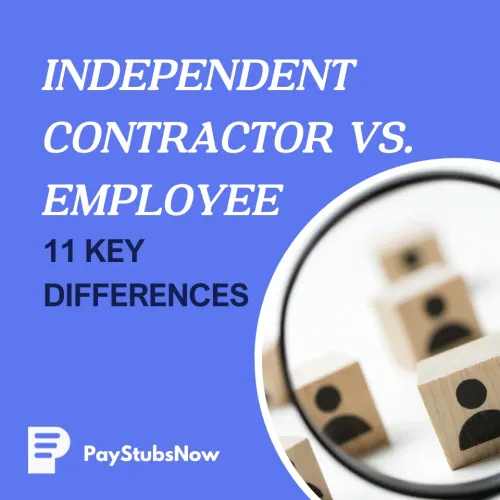


Understanding the difference between an independent contractor and an employee is not just a matter of policy for businesses. This classification influences everything from tax obligations to benefits, legal protections, and ongoing working relationships.
When the classification is correct, both organizations and workers can fulfill their responsibilities without confusion or risk of legal repercussions. However, if a worker is misclassified, even by accident, there can be a huge price to pay in the form of back taxes, hefty IRS fines, and lawsuits.
In this article, we’ll break down 11 differences between independent contractors and employees, focusing on factors such as control over work, payment methods, and legal protections. We will also discuss the IRS classification tests and explore the common risks of misclassification.

An independent contractor operates as a self-employed individual who provides services to businesses or clients. They often have the freedom to choose how to carry out their work and may work for multiple clients simultaneously. Importantly, they are responsible for managing their own tax obligations and are generally not entitled to the benefits that employees receive.
 An employee, in contrast, is someone who works for a business under its direction and control. Employees have specific job descriptions and are often working under long-term contracts. They receive wages, benefits, and legal protections tied to their employment status, such as health insurance and retirement plans, as well as protections against unlawful termination and workplace discrimination.
An employee, in contrast, is someone who works for a business under its direction and control. Employees have specific job descriptions and are often working under long-term contracts. They receive wages, benefits, and legal protections tied to their employment status, such as health insurance and retirement plans, as well as protections against unlawful termination and workplace discrimination.
 While both independent contractors and employees offer valuable services to a business, the nature of their relationship with the company and their respective responsibilities differ.
While both independent contractors and employees offer valuable services to a business, the nature of their relationship with the company and their respective responsibilities differ.
A defining factor differentiating independent contractors from employees is the level of control a business exercises. Employers usually dictate the manner in which employees complete their tasks and set specific work hours, outlining detailed processes for day-to-day functions.
On the other hand, independent contractors maintain a high degree of control over how they perform their work to meet agreed-upon deadlines or deliverables and decide on the methods and tools to use to achieve those results.
Employees typically receive training, attend regular meetings, and are closely supervised by their employers. This continuing relationship indicates that the business invests in the worker’s development and expects them to remain part of the organization’s daily operations.
Conversely, independent contractors tend to have project-specific or short-term engagements with minimal supervision and seldom receive training from the company. The relationship ends once the task is completed unless both parties agree to renew or extend the contract.
Employees usually work on-site at the employer's location and use company equipment. Independent contractors have the flexibility to work from wherever they choose and are generally responsible for providing their own tools and resources necessary for the job.
Many employers expect employees to work solely for them and may have strict non-compete or exclusivity clauses in the employment contract. Independent contractors typically offer services to multiple clients simultaneously.
If a business requires exclusivity from a contractor, the relationship may begin to resemble traditional employment, raising questions about worker classification.
In an employment relationship, the employer withholds and deposits income taxes, Social Security, and Medicare from the employee’s paycheck and pays a portion of unemployment taxes on the employee’s behalf.
Independent contractors handle their own taxes , which include both the employer and employee portions of Social Security and Medicare, and are also required to make estimated tax payments throughout the year to avoid penalties.
Employees typically receive paychecks on a regular schedule (e.g., weekly or biweekly) that reflect deductions for taxes, benefits, and other payroll withholdings. Independent contractors are paid by invoice according to contractual terms and do not receive standard pay stubs.
Tip: To maintain accurate records, independent contractors and companies can use tools like Paystubsnow to generate professional paystubs in minutes and keep track of payment details that support proper classification and financial documentation.
Employees are entitled to health insurance, retirement contributions, and paid leave. They are also protected by employment and labor laws, including minimum wage requirements, overtime rules, and anti-discrimination regulations.
Independent contractors are generally not entitled to these benefits and do not fall under most labor law protections in the same way that employees do.
Employees typically face minimal financial risk and rarely incur out-of-pocket expenses related to their work. They rely on their employer to provide the necessary tools, supplies, and insurance, and they are not directly affected by the company’s financial performance.
Contractors, on the other hand, invest in their independent businesses by purchasing their own equipment, software, and insurance. They also shoulder the financial risk if a project doesn’t generate the expected income. However, this greater risk is often offset by the potential for higher earnings through flexible rates and multiple contracts.
Employees are fully integrated into their employer's business, sharing in the company culture and working closely with various departments. They have designated workspaces and participate in strategic planning sessions.
Independent contractors, however, might work separately from the core business, focusing solely on specific tasks without the need for deep integration into the company's operations.
When it comes to termination, employees often have labor laws and company policies protecting them, meaning they usually cannot be dismissed without a 'just' cause.
Since independent contractors work under a contract that outlines how and when the engagement ends, they can only be terminated based on the explicit terms of their contracts, such as failing to meet agreed-upon milestones or deliverables.
Employees who lose their jobs through no fault of their own are usually eligible for unemployment benefits or severance pay, depending on company policy and state/federal laws.
Conversely, independent contractors do not qualify for unemployment benefits, which places them at an increased financial risk during periods without work.
To determine whether a worker is an independent contractor or an employee (a crucial distinction for federal tax purposes!), the IRS uses the following criteria:
This aspect deals with how much control a business has over the worker's behaviors. If an employer has the right to control how a worker performs their tasks, they are likely classified as an employee. On the contrary, if a worker operates autonomously and the employer merely outlines the desired outcomes, they may be classified as an independent contractor.
Financial control considers how the worker is compensated, whether they have unreimbursed expenses, and whether they have the potential for profit or loss based on their services. Employees typically have more predictable compensation, while independent contractors can negotiate rates and might incur additional expenses.
Contracts, benefits, and the expectation of permanence all play a role in defining the nature of the relationship between the worker and the employer. Non-compete agreements and insurance coverage can indicate an employee status, whereas the lack of benefits typically points to independent contractor status.
Note: Even if a contract clearly states a worker is an “independent contractor,” the IRS will examine the working relationship rather than just look at the label. If the business provides any kind of benefits to the contractor and expects a long-term working relationship, the arrangement might lean toward an employee-employer relationship.
There are some states, like California, where the ABC test is used. This test places the responsibility on employers to prove that a worker is:
(A) Free from the control and direction of the employer
(B) Performing work outside the usual course of the employer’s business
(C) Engaged in an independently established trade
 Misclassifying workers as employees or independent contractors can have severe consequences. Businesses must understand the risks associated with misclassification because if they’re found to be out of compliance with labor laws, they could be on the hook for:
Misclassifying workers as employees or independent contractors can have severe consequences. Businesses must understand the risks associated with misclassification because if they’re found to be out of compliance with labor laws, they could be on the hook for:
The IRS imposes fines and penalties on employers that misclassify employees. These can include monetary fines for each misclassified worker, in addition to interest on unpaid taxes. Repeated or intentional violations carry even steeper penalties.
If a worker was incorrectly designated as a contractor, the employer may be required to pay back taxes, which includes both the employer and employee portions of Social Security and Medicare , plus any additional state or local taxes. The business may also become liable for unpaid workers’ compensation premiums or unemployment insurance contributions.
Misclassified workers can file lawsuits or claims seeking compensation for unpaid overtime, minimum wage violations, or employment benefits. If the business loses these legal battles, it may have to retroactively provide benefits or payments.
In addition to fines imposed by the IRS, state labor agencies may enforce their own rules. These agencies could independently investigate the same employer, which could lead to additional penalties, magnifying the financial and administrative burden for businesses found to be non-compliant.
Misclassifying workers can also harm a business’s reputation. Not only can the business become liable for back taxes and fines, but this type of error can harm the brand’s image, negatively affect employee morale, and disrupt overall business operations.
To navigate the complexities of employee versus independent contractor classification, businesses can use tools like Paystubsnow.
Paystubsnow is an industry-leading paystub generation platform. This online platform offers tools for businesses to quickly generate payroll documentation like pay stubs and W-2 forms that are accurate and compliant with IRS guidelines. Independent contractors can also use this tool to generate invoices and 1099 tax forms. By maintaining accurate records, businesses can protect themselves from misclassification risks and streamline their payroll process.